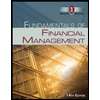
a)
To discuss:
Introduction:
Return: In financial context, return is seen as percentage that represents the profit in an investment.
b)
To discuss:
Average Rate of return.
Introduction:
Return: In financial context, return is seen as percentage that represents the profit in an investment.
c)
To discuss:
Standard deviation.
Introduction:
Return: In financial context, return is seen as percentage that represents the profit in an investment.
The standard deviation measures the volatility of the stock. It measures in absolute terms the dispersion of asset risk around its mean.
d)
To discuss:
Coefficient of variation
Introduction:
The coefficient of variation is an asset risk indicator that measures the relative dispersion. It describes the volatility of asset returns relative to its mean or expected return.
e)
To determine:
Investment decision
Introduction:
Risk: The risk can be defined as the uncertainty attached to an event such as investment where there is some amount of risk associated to it as there can be either gain or loss.
The coefficient of variation is an asset risk indicator that measures the relative dispersion. It describes the volatility of asset returns relative to its mean or expected return.
Want to see the full answer?
Check out a sample textbook solution
Chapter 8 Solutions
Gitman: Principl Manageri Finance_15 (15th Edition) (What's New in Finance)
- Which type of bond offers tax advantages? A) Convertible bondsB) Municipal bondsC) Corporate bondsD) Junk bondsneed help!arrow_forwardWhich type of bond offers tax advantages? A) Convertible bondsB) Municipal bondsC) Corporate bondsD) Junk bondsarrow_forwardWhat does "liquidity" refer to in finance? A) The profitability of a companyB) The ease of converting assets to cashC) The value of fixed assetsD) The number of outstanding shares i need answer.arrow_forward
- No chatgpt! What does "liquidity" refer to in finance? A) The profitability of a companyB) The ease of converting assets to cashC) The value of fixed assetsD) The number of outstanding sharesarrow_forwardWhat is the main purpose of budgeting in a company? A) To eliminate all expensesB) To forecast and control costsC) To increase revenueD) To reduce taxesarrow_forwardWhat does "liquidity" refer to in finance? A) The profitability of a companyB) The ease of converting assets to cashC) The value of fixed assetsD) The number of outstanding sharesarrow_forward
- I need answer in this problem quickly. The Weighted Average Cost of Capital (WACC) includes: A) Cost of equity and cost of debtB) Only the cost of equityC) Only the cost of debtD) Total revenue of the companyarrow_forwardHelp me in this question. The Weighted Average Cost of Capital (WACC) includes: A) Cost of equity and cost of debtB) Only the cost of equityC) Only the cost of debtD) Total revenue of the companyarrow_forwardNeed answer! The Weighted Average Cost of Capital (WACC) includes: A) Cost of equity and cost of debtB) Only the cost of equityC) Only the cost of debt D) Total revenue of the companyarrow_forward
- The Weighted Average Cost of Capital (WACC) includes: A) Cost of equity and cost of debtB) Only the cost of equityC) Only the cost of debtD) Total revenue of the companyarrow_forwardWhich of these is NOT part of the 4Ps in marketing but relevant to finance? A) PriceB) PromotionC) PlaceD) Profitabilityarrow_forwardI need correct answer. If a bond’s price increases, its yield will: A) IncreaseB) DecreaseC) Remain the sameD) Be unpredictablearrow_forward
 Fundamentals of Financial Management (MindTap Cou...FinanceISBN:9781285867977Author:Eugene F. Brigham, Joel F. HoustonPublisher:Cengage Learning
Fundamentals of Financial Management (MindTap Cou...FinanceISBN:9781285867977Author:Eugene F. Brigham, Joel F. HoustonPublisher:Cengage Learning Fundamentals of Financial Management (MindTap Cou...FinanceISBN:9781337395250Author:Eugene F. Brigham, Joel F. HoustonPublisher:Cengage Learning
Fundamentals of Financial Management (MindTap Cou...FinanceISBN:9781337395250Author:Eugene F. Brigham, Joel F. HoustonPublisher:Cengage Learning

